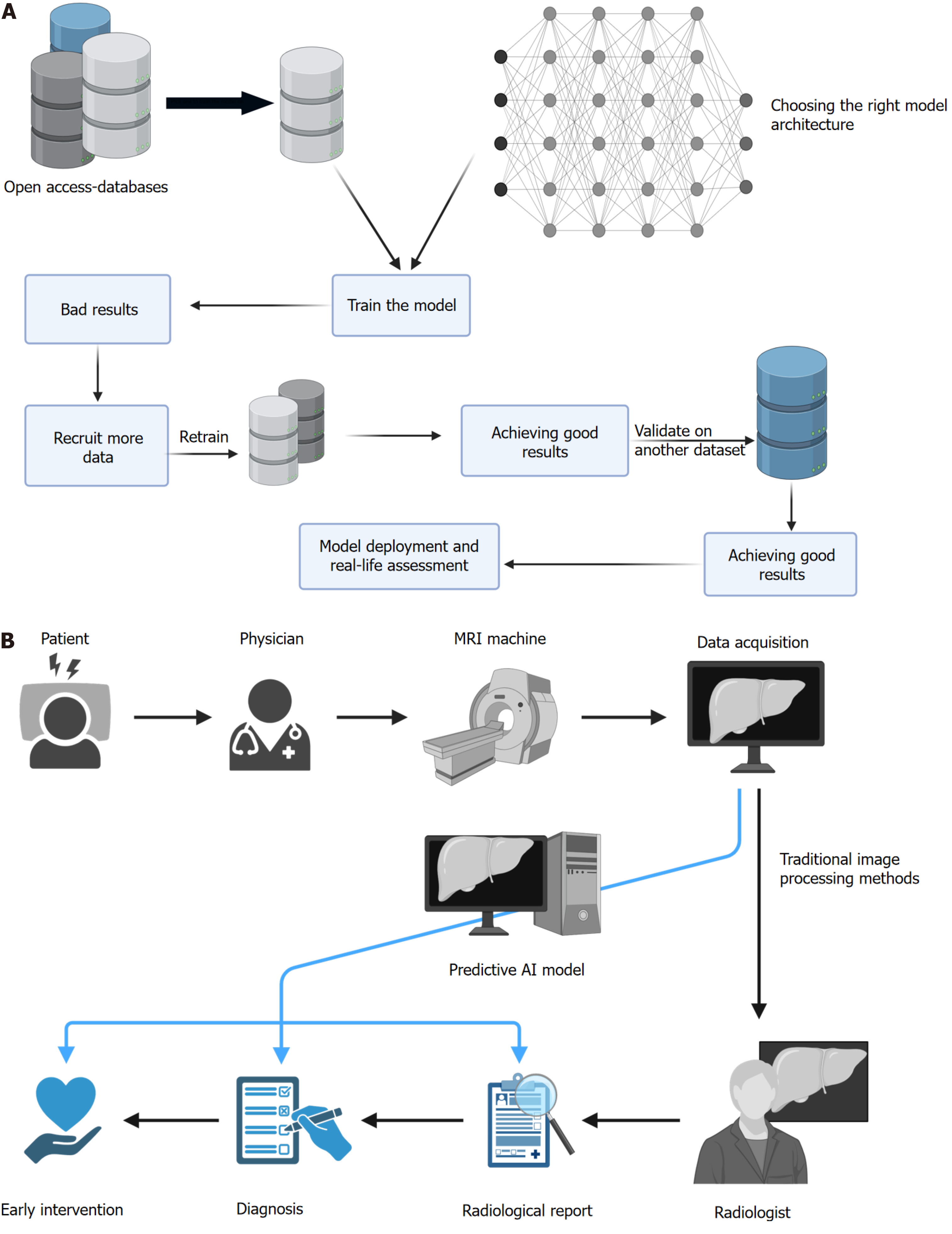Published online Jun 16, 2024. doi: 10.12998/wjcc.v12.i17.2921
Revised: April 4, 2024
Accepted: April 18, 2024
Published online: June 16, 2024
Processing time: 98 Days and 22.4 Hours
Artificial intelligence (AI), particularly machine learning (ML) and deep learning (DL) techniques, such as convolutional neural networks (CNNs), have emerged as transformative technologies with vast potential in healthcare. Body iron load is usually assessed using slightly invasive blood tests (serum ferritin, serum iron, and serum transferrin). Serum ferritin is widely used to assess body iron and dri
Core Tip: This editorial emphasizes the revolutionary impact of artificial intelligence (AI), particularly machine learning and deep learning techniques like convolutional neural networks (CNNs), in healthcare. Highlighting the limitations of tra
- Citation: Jaradat JH, Nashwan AJ. Revolutionizing disease diagnosis and management: Open-access magnetic resonance imaging datasets a challenge for artificial intelligence driven liver iron quantification. World J Clin Cases 2024; 12(17): 2921-2924
- URL: https://www.wjgnet.com/2307-8960/full/v12/i17/2921.htm
- DOI: https://dx.doi.org/10.12998/wjcc.v12.i17.2921
Artificial intelligence, the simulation of human intelligence by machines, is an emerging transformative technology in various fields, particularly healthcare. Machine learning (ML) and deep learning (DL) are two major classes of artificial intelligence (AI) that have revolutionized data analysis and decision-making. Convolutional neural networks (CNNs) are a subclass of DL, in which they are designed to learn spatial hierarchies of features adaptively and automatically. In heal
The growing capabilities of AI and CNNs offer immense potential for reducing human error and capturing minor and trivial differences that are difficult for a well-trained expert radiologist to capture and improve patient care, diagnosis, and treatment across various medical specialties[1].
Despite their increasing capabilities, it is essential to acknowledge the current limitations of AI in healthcare, such as interpretability, data privacy concerns, and the need for large and diverse datasets to train algorithms[1]. In medicine, large datasets are not an obstacle or concern because of the tremendous amount of patient data available and accessible to institutions. However, the challenge lies in curating and preparing the data and making it accessible to researchers (open access).
Iron body quantification and measurement are usually performed via slightly invasive methods, such as routine blood tests (serum ferritin, serum iron, and transferrin saturation)[2]. Serum ferritin is an acute phase reactant protein, elevated in inflammation and distressed patients, therefore, it might give wrong impression about body iron[2,3]. Noninvasive procedures are increasingly utilized for quantifying and assessing body iron load, and MRI is the best noninvasive exa
Evidence drawn from the literature on the use of AI for iron quantification and the detection of various liver diseases is insufficient. However, current literature shows promising results regarding iron quantification using MRI, and various models and algorithms have been used[3]. Furthermore, MRI has several windows, each focusing on certain body struc
To harness the full potential of CNNs and various ML algorithms in iron quantification and disease diagnosis, there is a demand for the creation and public release of standardized liver MRI datasets (see Figure 1). These datasets will not only accelerate research, but also improve diagnosis and ultimately benefit patients with iron overload disorders. By advo
Ferritin may provide false assessments of body iron levels in distressed patients. Well-documented large-scale datasets covering various MRI windows. Large-scale studies exploring various AI algorithms for iron quantification using MRI are required. Machine learning and deep learning have revolutionized disease diagnosis and treatment; therefore, they must be trained on large-scale multi-country, well-curated datasets.
In conclusion, the integration of AI and CNNs in healthcare, particularly medical imaging, presents a significant op
| 1. | Yamashita R, Nishio M, Do RKG, Togashi K. Convolutional neural networks: an overview and application in radiology. Insights Imaging. 2018;9:611-629. [RCA] [PubMed] [DOI] [Full Text] [Full Text (PDF)] [Cited by in Crossref: 1202] [Cited by in RCA: 1186] [Article Influence: 169.4] [Reference Citation Analysis (0)] |
| 2. | Hernando D, Levin YS, Sirlin CB, Reeder SB. Quantification of liver iron with MRI: state of the art and remaining challenges. J Magn Reson Imaging. 2014;40:1003-1021. [RCA] [PubMed] [DOI] [Full Text] [Cited by in Crossref: 163] [Cited by in RCA: 208] [Article Influence: 18.9] [Reference Citation Analysis (0)] |
| 3. | Nashwan AJ, Alkhawaldeh IM, Shaheen N, Albalkhi I, Serag I, Sarhan K, Abujaber AA, Abd-Alrazaq A, Yassin MA. Using artificial intelligence to improve body iron quantification: A scoping review. Blood Rev. 2023;62:101133. [RCA] [PubMed] [DOI] [Full Text] [Cited by in Crossref: 10] [Reference Citation Analysis (0)] |
| 4. | Feng Q, Yi J, Li T, Liang B, Xu F, Peng P. Narrative review of magnetic resonance imaging in quantifying liver iron load. Front Med (Lausanne). 2024;11:1321513. [RCA] [PubMed] [DOI] [Full Text] [Reference Citation Analysis (0)] |
| 5. | Tziomalos K, Perifanis V. Liver iron content determination by magnetic resonance imaging. World J Gastroenterol. 2010;16:1587-1597. [RCA] [PubMed] [DOI] [Full Text] [Full Text (PDF)] [Cited by in CrossRef: 35] [Cited by in RCA: 31] [Article Influence: 2.1] [Reference Citation Analysis (0)] |









